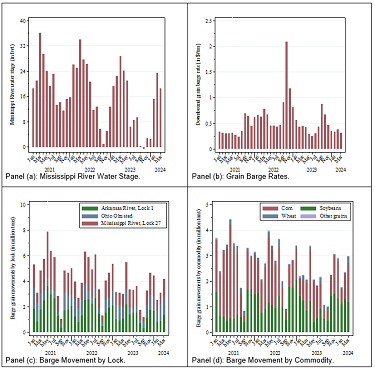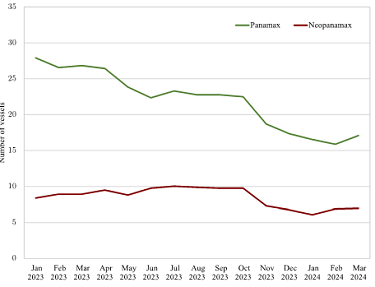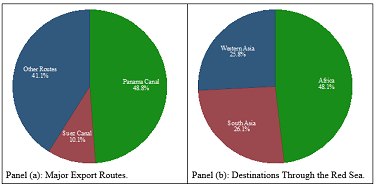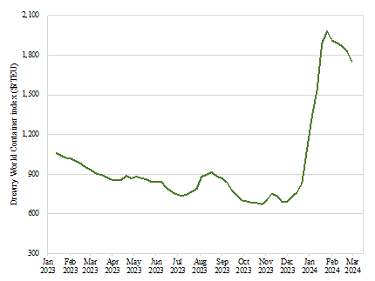
U.S. agriculture is critical to global food security and one of world trade’s dependable staples. In 2022, the agricultural sector and related industries contributed 5.6% to the U.S. gross domestic product and employed 10.4% of the U.S. population. The sector’s strength depends not only on domestic factors—such as crop yields, demand, and agricultural policies—but also on its ability to access foreign markets. Agricultural exports have grown considerably over the last few decades, reaching almost $200 billion in 2022 (U.S. Department of Agriculture, 2024a). Recent disruptions in critical transportation lanes—including the Panama Canal, the Red Sea, and the Mississippi River—have highlighted the vulnerability of U.S. agriculture to climate disruptions and geopolitical events. These shipping routes facilitate the timely and cost-effective transportation of vast quantities of agricultural commodities—including major staples like corn, soybeans, and wheat—to international markets.
The Panama Canal, a critical route for global maritime trade, has recently experienced its most severe drought in history, leading to unprecedented restrictions on vessel transits. This reduction has significantly decreased the canal’s capacity, dropping from an average of 36 ship crossings per day to around 24 (Steinbach, Yildirim, and Zhuang, 2024). The operational cutback is a logistical challenge for U.S. agriculture and a substantial economic blow to the Canal authorities, with revenue losses estimated between $500 and $700 million in fiscal year 2024. The bottleneck affects nearly 3% of global maritime trade volumes, emphasizing the canal’s crucial role in linking the Atlantic and Pacific Oceans.
Similarly, the 2022 and 2023 Mississippi River droughts disrupted barge transportation of agricultural commodities, an essential logistics mode for moving goods from the Midwest to the Gulf of Mexico ports. The 2022 drought reduced agricultural exports from Louisiana ports, with a 3.9% decrease translating intotrade losses of $565 million between July 2022 and January 2023 (Steinbach and Zhuang, 2023). These authors show that wheat exports were notably affected, experiencing a sharp decline in volume. In contrast, other commodities like soybeans and corn experienced no statistically significant impact, illustrating varied impacts across different agricultural sectors.
Further, geopolitical instability in the Red Sea region has complicated global shipping dynamics. The heightened military tensions and attacks on commercial vessels by the Houthi terrorist group have necessitated the rerouting of significant maritime traffic to alternative paths, such as the Cape of Good Hope (Goyal et al., 2024). This adjustment has extended transit times and led to a dramatic surge in freight rates, escalating from about $700 to over $1,900 per 20-foot equivalent unit (TEU) from November 2023 to January 2024 (Hinz and Rauck, 2024). These disruptions highlight the fragile nature of vital maritime routes and their profound impact on U.S. agricultural exports.
These dual challenges of climate and geopolitical disruptions place U.S. agriculture at a critical juncture. The ongoing drought in the Panama Canal and the military tensions in the Red Sea represent substantial threats to the stability and efficiency of global agricultural supply chains and U.S. market access. Because these trade routes are vital for exporting American agricultural products, mainly to Asian markets, the current situation calls for an urgent reassessment of trade and logistical strategies. There is a growing need for robust, adaptive measures as the sector must deal with an increasingly uncertain global trade environment marked by natural and man-made challenges.

In 2022, the Mississippi River experienced one of its most severe droughts, significantly disrupting thetransportation network essential for U.S. agricultural exports. The river, a major conduit for transporting agricultural commodities from the Midwest to the Gulf of Mexico, saw dramatically reduced water levels, affecting barge traffic—one of the most cost-effective methods of moving bulk agricultural products. The 2020 modal share for U.S. grain exports was 46% by barge, 38% by rail, and 16% by truck, highlighting the critical role that barge transportation plays in the export market (Henderson, Gastelle, and Caffarelli, 2023). A recent study by Steinbach and Zhuang (2023) highlighted that this logistical bottleneck led to a 3.9% reduction in agricultural exports from Louisiana ports, translating into an economic loss of $563.9 million from July 2022 to January 2023. This downturn primarily impacted wheat exports, which saw a notable decrease in volume by 350 million kilograms at Louisiana ports. Other factors may have also contributed to the reduction in wheat exports, which are attributable to reduced yields, crop choices, and increased international competition.
While some commodities like soybeans and corn were less affected, the drought underscored the vulnerability of agricultural logistics to climate variations. The impact was not evenly distributed: Ports other than the Louisiana Gulf experienced even more pronounced trade disruptions, with a reduction of 15.1% compared to the lesser effect at Louisiana ports. The situation led to trade diversion, where agricultural suppliers sought alternative transportation routes or shifted their exports to East and West Coast ports, as evidenced by a positive trade effect of 5.8% and 7.1% for these regions, respectively. As Figure 1 shows, the drought conditions on the Mississippi River have had major implications for barge rates and have become a reoccurring challenge at the Mississippi River. The logistical challenges posed by the reduced water levels underscored the vulnerability of relying heavily on a single route for exports. Diversifying logistics and sourcing strategies is essential to mitigate such risks and ensure resilience in U.S. agricultural trade.

Simultaneously, the Panama Canal faces challenges due to an unprecedented drought exacerbated by the El Niño weather phenomenon and broader climate change impacts since Fall 2023. Typically facilitating about 36 ship crossings daily, the canal’s capacity was reduced by 30% due to the drought, limiting daily crossings to approximately 24 ships, marking a substantial reduction in operational throughput, as shown in Figure 2. This decrease in capacity impacts nearly 3% of global maritime trade volumes as they transit through the Panama Canal. This route predominantly uses dry bulk carriers, container ships, chemical and crude product tankers, and liquefied petroleum gas carriers. Notably, container ships have suffered less from the increase in waiting times for transit, which averaged five days in July and escalated to more than three weeks in January 2024.
The operational cutbacks at the canal are a logistical challenge and pose a substantial economic setback for the Panama Canal authorities and U.S. agricultural exporters. The first quarter of fiscal year 2024 alone witnessed a 20% decrease in cargo volume, leading to 791 fewer ships than the previous year (Lim, Steinbach, and Zhuang, 2024). This situation profoundly affected U.S. agricultural exports, particularly grains and oilseeds, which rely heavily on this route for accessing Asian markets. The delays and increased shipping costs directly translated into higher prices for agricultural products abroad, potentially compromising their competitiveness in international markets.

The Red Sea region, a critical maritime passageway for global trade, has recently been a hotspot for geopolitical instability, severely affecting the flow of U.S. agricultural commodities. Heightened military tensions and direct attacks on commercial vessels by the Houthi terrorist organization have led to significant disruptions in this vital shipping lane (Goyal et al., 2024). The attacks prompted a substantial diversion of maritime traffic, with a marked increase in vessels opting for longer routes, such as around the Cape of Good Hope. This rerouting extended transit times dramatically and escalated operational costs. As Hinz and Rauck (2024) noted, about 85% of global container vessels were forced to travel via this alternative route in January 2024, showing the extensive impact of these disruptions on global shipping logistics.
These geopolitical tensions directly affect U.S. agricultural exports, particularly those commodities reliant on timely deliveries to competitive international markets. For example, the Red Sea is an essential route for U.S. grain exports. As illustrated in Figure 3, 10.1% of Gulf grain exports transit through the Suez Canal. Of these grain exports passing through the Red Sea, 51.9% are destined for Asia, while 48.1% are shipped to Africa. The extended shipping times and increased freight rates have raised the cost of exporting goods, impacting the price competitiveness of U.S. agricultural products abroad. As shown in Figure 4, the average cost of transporting a standard TEU surged from about $700 in November 2023 to over $1,900 in January 2024. More recent projections indicate the possibility of even higher rates moving forward (Steinbach, Yildirim, and Zhuang, 2024). Such cost inflations are particularly burdensome for the agricultural sector, where margins are often tight, and market prices can be susceptible to supply chain inefficiencies.
The ongoing military tensions in the Red Sea have disrupted traditional shipping routes, heightened insurance costs, and increased the risk premium on cargo fees (Goyal et al., 2024). Insurers are increasingly wary of covering routes that pass through high-risk areas, leading to a rise in insurance premiums. This additional cost burden is inevitably passed down the supply chain, culminating in higher consumer prices and reduced profit margins for U.S. agricultural exporters. The instability in the region thus poses a dual challenge of managing both increased operational costs and the complexities of international insurance and risk management.

The convergence of climate-related disruptions andgeopolitical instability has created a compounded challenge for U.S. agricultural trade. Severe droughts simultaneously affecting both the Panama Canal and the Mississippi River alongside military tensions in the Red Sea exemplify how these dual pressures can severely disrupt key logistic arteries for U.S. agriculture. Reduced capacity at the Panama Canal due to drought conditions and rerouted shipping paths around the Cape of Good Hope due to Red Sea tensions have increased transportation costs and extended delivery times. These disruptions highlight a critical vulnerability in the reliance on key transit routes, which are susceptible to natural and man-made crises and affect the overall efficiency and reliability of U.S. foreign supply chains.
The broader implications for U.S. agricultural exporters include increased operational costs, risk of spoilage for perishable goods, and heightened financial pressure. Increased shipping costs and extended transit times also lead to higher consumer prices and reduced global competitiveness of U.S. agricultural products. Additionally, these disruptions can force a reevaluation of existing supply chain strategies, prompting companies to explore alternative routes, invest in more robust risk management strategies, or even reconsider the geographic diversity of their markets. The impacts can be even more pronounced for markets highly dependent on timely deliveries, such as fresh produce, leading to potential losses in U.S. market share as importers seek more reliable sources.
These combined challenges affect market access for U.S. agricultural products and have the potential to reshape global trade dynamics. Extended shipping times and higher costs may lead international buyers to seek alternatives, which could shift trade patterns and influence the strategic decisions of U.S. exporters. Thissituation underscores the need for a more resilient agricultural supply chain that can adapt to sudden climate changes and geopolitical shifts. Building such resilience might involve enhancing infrastructural flexibility, diversifying export markets, and increasing collaboration between government and industry to mitigate the impacts of future disruptions. Ultimately, these efforts will help secure a stable and accessible market presence for U.S. agricultural products in an increasingly unpredictable global trade environment.
To mitigate risks associated with climate and geopolitical instabilities, agricultural stakeholders should consider diversifying their logistics and sourcing strategies. By diversifying the number and location of import and export ports, agricultural exporters can reduce dependency on single routes like the Mississippi River or the Panama Canal. For example, increasing investment in ports like the Port of Seattle or the Port of New York and New Jersey can offer viable alternatives for accessing Asian markets, especially when southern routes are compromised. Additionally, expanding the integration of multimodal transport systems—which combine rail, road, and barge—can enhance logistical flexibility. Organizations such as the American Association of Port Authorities and the U.S. Department of Transportation are pivotal in advocating for and implementing such diversification strategies.
Targeted policy interventions could be essential to ensure the resilience of U.S. agricultural trade. Expanding strategic grain reserves at critical global locations would buffer against sudden supply shocks caused by climatic events or geopolitical crises. Further, international co-operation must be strengthened to secure maritime corridors, especially in volatile regions like the Red Sea. Agreements on safe passage need to be enforced by a broad coalition. International bodies—such as the United Nations Conference on Trade and Development and the International Maritime Organization, which have mandates to enhance the integration of developing countries into the world economy and promote safe, secure, and efficient shipping—could facilitate emergency rerouting protocols.
Investments in climate-resilient infrastructure are vital for sustainable U.S. agricultural trade. Upgrading canal systems to withstand extreme weather conditions better and integrating advanced meteorological technologies would enable better preparedness and response to climatic disruptions. Organizations like the Food and Agriculture Organization and the U.S. Department of Agriculture could support policies encouraging the adoption of precision agriculture technologies that optimize resource use and reduce environmental impact. These institutions could provide additional financial incentives, such as subsidies or tax breaks, to promote sustainable practices among farmers, enhancing the overall resilience of the U.S. agricultural sector.
Enhancing international dialogue and co-operation to address geopolitical tensions is crucial for creating a stable global trade environment for U.S. agriculture. Diplomatic engagement and conflict resolution mechanisms spearheaded by the World Trade Organization and regional groups like the Association of Southeast Asian Nations should preemptively tackle potential trade disruptions. These organizations can facilitate discussions and agreements to safeguard commercial interests and ensure the safety of maritime transport routes. Expanding robust international legal frameworks through the International Court of Justice could also provide a legal basis for protecting these critical routes and deterring threats, thereby fostering a secure environment for U.S. agricultural exporters.
Recent climate and geopolitical challenges have highlighted the vulnerabilities in critical global trade routes essential for the timely and cost-effective transportation of U.S. agricultural products. These disruptions underscore the dependent nature of agricultural trade and the critical impact that both natural and human-made crises can have on the stability of U.S. food supply chains. Strategies such as diversifying logistic routes, investing in climate-resilient infrastructure, and enhancing international co-operation are crucial for mitigating these risks and ensuring the continuous flow of U.S. agricultural commodities in the global market.
In a world where unpredictability is becoming the norm, the U.S. agricultural sector must adopt proactive measures. Federal and state policies must respond to immediate disruptions and help to adapt and mitigate long-term challenges by building a more resilient and adaptable trade transportation infrastructure. This involves expanding collaboration among governments, international organizations, and the private sector todevelop policies and frameworks safeguarding against future crises. By doing so, the United States can ensure that its agricultural sector remains competitive in an increasingly dynamic global environment, thus maintaining its essential role in feeding the world.
RiverGages. 2024, April 15. “Water Levels of Rivers and Lakers.” Available online: https://rivergages.mvr.usace.army.mil/WaterControl/new/layout.cfm/
Steinbach, S., and X. Zhuang. 2023. “US Agricultural Exports and the 2022 Mississippi River Drought.” Agribusiness, first published online. Available online: https://doi.org/10.1002/agr.21880
Steinbach, S., Y. Yildirim, and X. Zhuang. 2024, January 29. “Ripple Effects of Shipping Lane Disruptions on U.S. Agriculture.” Farmdoc Daily (14):19. Available online: https://farmdocdaily.illinois.edu/2024/01/ripple-effects-of-shipping-lane-disruptions-on-u-s-agriculture.html
Sea-Distances. 2024, June 15. “Online Tool for Calculation Distances Between Sea Ports.” Available online: https://sea-distances.org
U.S. Department of Agriculture. 2024a. “U.S. Agricultural Trade at a Glance.” USDA Economic Research Service. Available online https://www.ers.usda.gov/topics/international-markets-u-s-trade/u-s-agricultural-trade/u-s-agricultural-trade-at-a-glance/
——. 2024b, March 12. “Grain Transportation Report Datasets.” USDA Agricultural Marketing Service. Available online: https://www.ams.usda.gov/services/transportation-analysis/gtr-datasets